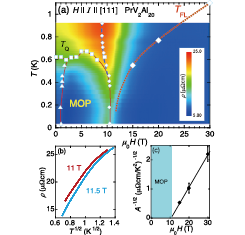Field-Induced Quadrupolar Quantum Criticality in PrV2Al20
Nakatsuji Group
Extensive studies have revealed nontrivial metallic phenomena associated with a magnetic quantum criticality in various correlated electron systems. Whether another type of instability due to orbital degree of freedom may drive novel types of metallic states and unconventional superconductivity has been an active area of research. Since f-electron systems may provide a non-magnetic crystal-electric-field (CEF) ground-state doublet, where orbitals are the only active degree of freedom, we can study the pure orbital contribution. In fact, some Pr (4f2)-based cubic compounds are found to host the Γ3 non-Kramers ground-state doublet, which has no magnetic moment but carries an electric quadrupole moment. A number of cubic 4f2Γ3 systems were studied and various interesting electric phenomena were experimentally reported including a ferro and antiferro quadrupolar ordering. As a competing effect, a non-magnetic form of the Kondo effect has been proposed that quenches the quadrupole moments. Thus, the tuning of these competing effects may lead to quadrupolar quantum criticality.

Fig. 1. (a) Magnetic phase diagram of PrV2Al20 with magnetic fields, and current I, parallel to the [111] direction. Color plot indicates the ρ(H, T) values obtained from the field H scans at a constant T. Circles indicate the peak position at Hc = 11 T, separating the low field multipolar ordering phase (MOP) and the paraquadrupolar state at high fields. Triangles represent small peaks observed in ρ(H) for fields below 2 T. The solid line and broken line show the transition temperature/field of the multipole ordered phase and the peak position in ρ(H), respectively. Squares and diamonds respectively indicate TQ and a characteristic temperature TFL below which ρ(T) follows the Fermi-liquid T2 law. The dotted line is a guide to the eyes. (b) ρ as a function of T1/2 under H = 11 T and 11.5 T. (c) Field dependence of A-1/2, where A is the T2 coefficients in ρ(T). According to the standard Fermi liquid theory, the effective mass m* is proportional to A1/2
In fact, strong hybridization effects and quadrupolar quantum criticality have been suggested by recent intensive studies on the new cubic Γ3 systems PrT2Al20, where T corresponds to transition metals such as Ti and V [1-5]. Evidence for strong hybridization in PrV2Al20 is further provided by the recent discovery of heavy-fermion superconductivity at Tc = 50 mK in the quadrupolar ordered state below TQ = 0.6 K [4]. The effective mass of the quasiparticles participating into the superconducting condensate was found to be as large as 140 m0[4]. This result indicates that PrV2Al20 should be located in the vicinity of a QCP associated only with multipole moments. To realize such quantum criticality due to multipole moments, the magnetic field is one of the useful control parameters. The quantum criticality is expected to be observed near the critical field of the quadrupolar ordered state with TQ = 0.6 K on the basis of the similarity to the magnetically ordered system. The quadrupole ordered state has a nearly H-independent transition temperature under the magnetic field below 9 T, which becomes anisotropic in the higher field [1, 5].
We report the discovery of a field-tuned quantum criticality based solely on the quadrupolar (orbital) degrees of freedom in PrV2Al20 through the magneto-transport measurements up to 35 T by using the high DC magnetic field facilities at the National High Magnetic Field Laboratory [6].
Our study on PrV2Al20 reveals the field-induced quadrupolar quantum criticality at the critical field Hc = 11 T applied along the [111] direction. Near Hc required to suppress the quadrupolar state, we found a marked enhancement of the resistivity ρ(H, T) (Fig. 1 (a)), concomitant non-Fermi liquid (NFL) behavior following ρ(T ) ~ Tn with n < 0.5 in the vicinity of critical field (Fig. 1 (b)), and a divergent quasiparticle effective mass as a function of the magnetic field toward critical field of 11 T (Fig. 1 (c)). We also observed the Shubnikov-de Haas oscillation above Hc, indicating an effective mass enhancement up to m*/m0 ~ 10. These reveal the field induced quadrupolar quantum criticality where the competition between the nonmagnetic Kondo effect and the intersite quadrupolar coupling leads to pronounced NFL behaviors in an extensive region of T and H around the quantum critical point.
References
- [1] A. Sakai and S. Nakatsuji, J. Phys. Soc. Jpn. 80, 063701 (2011).
- [2] A. Sakai, K. Kuga, and S. Nakatsuji, J. Phys. Soc. Jpn. 81, 083702 (2012).
- [3] K. Matsubayashi, T. Tanaka, A. Sakai, S. Nakatsuji, Y. Kubo, and Y. Uwatoko, Phys. Rev. Lett. 109, 187004 (2012).
- [4] M. Tsujimoto, Y, Matsumoto, T. Tomita, A. Sakai, and S. Nakatsuji, Phys. Rev. Lett. 113, 267001 (2014).
- [5] Y. Shimura, Y. Ohta, T. Sakakibara, A. Sakai and S. Nakatsuji, J. Phys. Soc. Jpn. 82, 043705 (2013).
- [6] Y. Shimura, M. Tsujimoto, B. Zeng, L. Balicas, A. Sakai, and S. Nakatsuji, to be published in Phys. Rev. B (2015).
